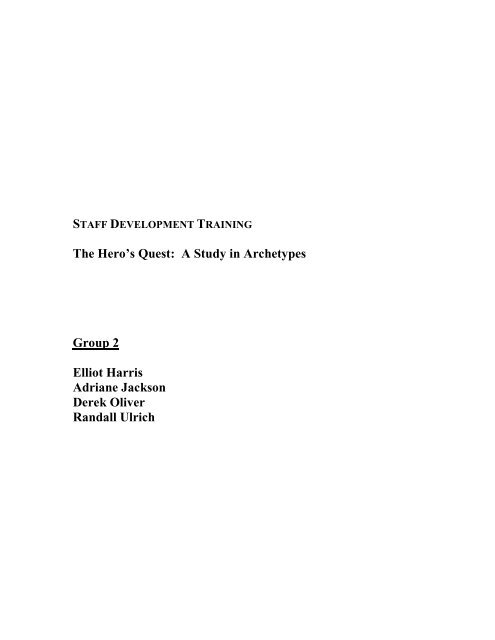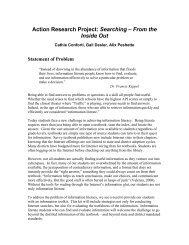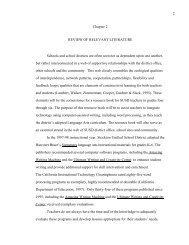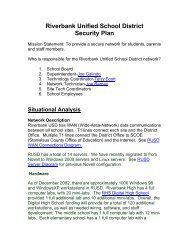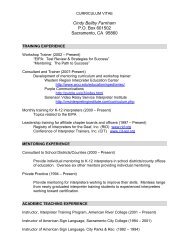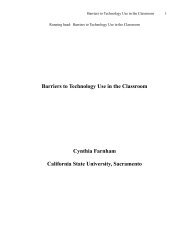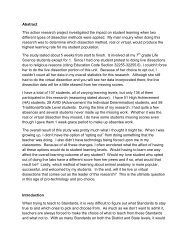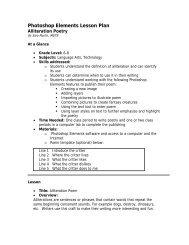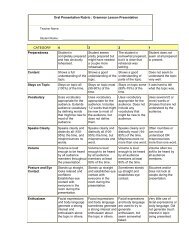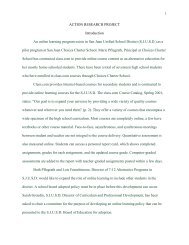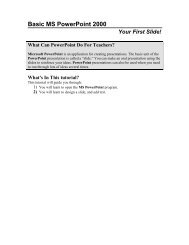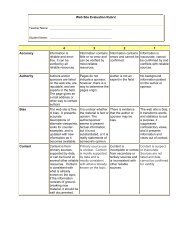The Hero's Quest: A Study in Archetypes Group 2 Elliot Harris ... - iMET
The Hero's Quest: A Study in Archetypes Group 2 Elliot Harris ... - iMET
The Hero's Quest: A Study in Archetypes Group 2 Elliot Harris ... - iMET
Create successful ePaper yourself
Turn your PDF publications into a flip-book with our unique Google optimized e-Paper software.
STAFF DEVELOPMENT TRAINING<strong>The</strong> Hero’s <strong>Quest</strong>: A <strong>Study</strong> <strong>in</strong> <strong>Archetypes</strong><strong>Group</strong> 2<strong>Elliot</strong> <strong>Harris</strong>Adriane JacksonDerek OliverRandall Ulrich
AgendaDAY 19:00 AMWelcome and IntroductionsIcebreaker activity: “Toss the Toy” <strong>in</strong>troductions• Us<strong>in</strong>g a soft stuffed animal or other similar device, have attendee who is hold<strong>in</strong>gthe stuffed animal <strong>in</strong>troduce him/herself with the follow<strong>in</strong>g <strong>in</strong>formation:o Nameo School district or other organizationo Grade taughto Expectations of today’s tra<strong>in</strong><strong>in</strong>g• When completed, holder of stuffed animal should toss it to a random member ofthe audience.o Repeat <strong>in</strong>formation for each attendee until all attendees have providedtheir <strong>in</strong>troductory <strong>in</strong>formation.• Last attendee should toss the stuffed animal to the facilitator, who gives his/herbio <strong>in</strong>formation.Arrange <strong>in</strong>to groups activity: “5 Card Stud”• With a standard deck of cards, everyone is given a s<strong>in</strong>gle card.• Participants are <strong>in</strong>structed to get up and m<strong>in</strong>gle with the entire group.• By compar<strong>in</strong>g cards, participants form the best poker hand possible.• <strong>The</strong>se poker hands now form the basis of work<strong>in</strong>g groups.Overview of class• Overview of the tra<strong>in</strong><strong>in</strong>g session.• Duration of tra<strong>in</strong><strong>in</strong>g, review of agenda, exercises dur<strong>in</strong>g tra<strong>in</strong><strong>in</strong>g, post-tra<strong>in</strong><strong>in</strong>gsurvey.• Housekeep<strong>in</strong>g: breaks, emergency exits, emergency phone numbers, facilities(heat, A/C), facilitator contact <strong>in</strong>formation for follow-up, cell phone policy, lunchbreaks and locations for food, etc.10:00 AM BREAK10:15 AM<strong>The</strong> Hero’s Journey: A review of its structure<strong>The</strong> Hero’s Journey <strong>in</strong> modern literature and American culture• Review the structure of the Hero’s Journey. Ensure that everyone understands thestructure.• Guided discussion concern<strong>in</strong>g f<strong>in</strong>d<strong>in</strong>g the Hero’s Journey <strong>in</strong> modern day literatureand <strong>in</strong> American culture.• Examples of modern versions of the Hero’s Journey displayed through onl<strong>in</strong>esources.
Agenda12:00 PM LUNCH1:00 PMWebquest: Introductions, Overviews, Examples• Introduction of the concept of webquests.• Demonstration of webquest through onl<strong>in</strong>e sites and exemplars.• Uses <strong>in</strong> the classroom, group projects, and assignments related to Language Arts.2:00 PM BREAK2:15 PMReview of the student assignment: Requirements and resources.• Review the requirements for the student assignment: webquest and the Hero’sJourney.• Review the resources available for this assignment.• L<strong>in</strong>k to student assignment web site.END OF DAY 1
AgendaDAY 29:00 AMReview and questionsDiscussion of tools used for presentation and feedback• Review the previous day’s <strong>in</strong>formation. Allow for questions related to prior day’stra<strong>in</strong><strong>in</strong>g. Follow up as necessary.• Beg<strong>in</strong> discussion of onl<strong>in</strong>e tools related to webquest.10:00 AM BREAK10:15 AMUse of Voicethread, with exercises• Introduction to Voicethread. (Refer to Voicethread <strong>in</strong>structional handout.)• Exercises:o Create <strong>in</strong>dividual accounts on Voicethread. (Onl<strong>in</strong>e tutorial:http://t<strong>in</strong>yurl.com/ygppq8n -or- http://t<strong>in</strong>yurl.com/y9zul3a.)o Create short slideshow, add comments (text, video, or voice). Onl<strong>in</strong>etutorial: http://t<strong>in</strong>yurl.com/yapy2vm -or- http://t<strong>in</strong>yurl.com/yh5ydnx.)o F<strong>in</strong>d a classmate’s slideshow, and add comments to that slideshow.o F<strong>in</strong>d Hero’s Journey exemplar: http://t<strong>in</strong>yurl.com/y9ru56e (see alsohttp://voicethread.com/#u533228.b741445), and add a video, audio, or textcomment.o Materials needed: handout on how to create an account on Voicethread.12:00 PM LUNCH1:00 PMBra<strong>in</strong>storm<strong>in</strong>g alternate post<strong>in</strong>gs of f<strong>in</strong>ished assignment.Exercise: flip charts, Post-Its, wikis, blogs, YouTube• Exercise:o Gather<strong>in</strong>g <strong>in</strong>to groups, participants beg<strong>in</strong> to bra<strong>in</strong>storm ideas concern<strong>in</strong>ghow students can post their completed assignments.o Participants gather <strong>in</strong>to groups, and use Post-It notes and markers tooutl<strong>in</strong>e their ideas.o Discussion cont<strong>in</strong>ues with<strong>in</strong> groups to f<strong>in</strong>alize ideas.o At the end of discussion period, all groups show their flip chart results andthen compare notes as a group on merits of each approach.• Materials needed:o Flip charts.o Markers.o Computers to access various wikis, blogs, videos, Wikipedia, etc.
AgendaAlternate feedback methods (wikis, blogs, Google Docs)• Introduce alternate feedback methods students can use for their projects.• Review relative merits of each type of feedback mechanism.2:00 PM BREAK2:15 PMReview literature focus<strong>in</strong>g on use of technology <strong>in</strong> the classroom, <strong>in</strong>corporat<strong>in</strong>g <strong>in</strong>toassignments, and use of web 2.0 tools as feedback mechanisms.Wrap-up/SummaryF<strong>in</strong>al questionsPost-tra<strong>in</strong><strong>in</strong>g surveys• Post-tra<strong>in</strong><strong>in</strong>g satisfaction survey: http://www.surveymonkey.com/s/DR3BV5Go Complete before participants leave.• Staff development post-tra<strong>in</strong><strong>in</strong>g survey (six weeks post-tra<strong>in</strong><strong>in</strong>g):http://www.surveymonkey.com/s/958RZVQo Are teachers <strong>in</strong>corporat<strong>in</strong>g today’s tra<strong>in</strong><strong>in</strong>g <strong>in</strong>to their lesson plans?END OF DAY 2
ResourcesHandouts:1. Agenda (Facilitator’s Guide Activity List)2. California Teach<strong>in</strong>g Standards3. Suggested Read<strong>in</strong>g / Review of Literature4. List of web sites to visit5. Step-by-step Voicethread account creation6. Post-tra<strong>in</strong><strong>in</strong>g onl<strong>in</strong>e surveys (2)Equipment needed:1. Computers for participantsa. Dedicated tra<strong>in</strong><strong>in</strong>g room with computers and Internet accessb. Students br<strong>in</strong>g their own laptops and have wireless access to the Internet2. Flip charts3. Pens and markers4. Post-It notes5. Overhead projector6. Instructor computer with Internet access7. Stuffed animal/toy for Icebreaker activity8. Deck of standard play<strong>in</strong>g cards for group selection activityRoom layout:1. Room should be set up with “islands” of work stationsa. Flip charts located at each work stationb. Pens, markers, and Post-It notes should be piled on each workstationAudience/Capacity:1. Audience should consist of no more than 20 attendees.2. Four groups of five members, after play<strong>in</strong>g “5 Card Stud” game.
HANDOUTS1. Agenda (Facilitator’s Guide Activity List)2. California Teach<strong>in</strong>g Standards3. Suggested Read<strong>in</strong>g / Review of Literature4. List of web sites to visit5. Step-by-step Voicethread account creation6. Post-tra<strong>in</strong><strong>in</strong>g onl<strong>in</strong>e surveys (2)
StandardsCa ELA 11th and 12th grade2.0 Writ<strong>in</strong>g Applications (Genres and <strong>The</strong>ir Characteristics) Students comb<strong>in</strong>e the rhetoricalstrategies of narration, exposition, persuasion, and description to produce texts of at least 1,500words each. Student writ<strong>in</strong>g demonstrates a command of standard American English and theresearch, organizational, and draft<strong>in</strong>g strategies outl<strong>in</strong>ed <strong>in</strong> Writ<strong>in</strong>g Standard 1.2.6 Deliver multimedia presentations: a. Comb<strong>in</strong>e text, images, and sound and draw<strong>in</strong>formation from many sources (e.g., television broadcasts, videos, films, newspapers,magaz<strong>in</strong>es, CD-ROMs, the Internet, electronic media-generated images). b. Select an appropriatemedium for each element of the presentation. c. Use the selected media skillfully, edit<strong>in</strong>gappropriately and monitor<strong>in</strong>g for quality. d. Test the audience’s response and revise thepresentation accord<strong>in</strong>gly.2.4 Deliver multimedia presentations: a. Comb<strong>in</strong>e text, images, and sound by <strong>in</strong>corporat<strong>in</strong>g<strong>in</strong>formation from a wide range of media, <strong>in</strong>clud<strong>in</strong>g films, newspapers, magaz<strong>in</strong>es, CD-ROMs,onl<strong>in</strong>e <strong>in</strong>formation, television, videos, and electronic media-generated images. b. Select anappropriate medium for each element of the presentation. c. Use the selected media skillfully,edit<strong>in</strong>g appropriately and monitor<strong>in</strong>g for quality. d. Test the audience’s response and revise thepresentation accord<strong>in</strong>gly.Teach<strong>in</strong>g standard: California Standards for the Teach<strong>in</strong>g ProfessionSTANDARD FOR PLANNING INSTRUCTION AND DESIGNING LEARNINGEXPERIENCES FOR ALL STUDENTSTeachers plan <strong>in</strong>struction that draws on and values students' backgrounds, prior knowledge, and<strong>in</strong>terests. Teachers establish challeng<strong>in</strong>g learn<strong>in</strong>g goals for all students based on studentexperience, language, development, and home and school expectations. Teachers sequencecurriculum and design long-term and short-range plans that <strong>in</strong>corporate subject matterknowledge, reflect grade-levelcurriculum expectations, and <strong>in</strong>clude a repertoire of <strong>in</strong>structional strategies. Teachers use<strong>in</strong>structional activities that promote learn<strong>in</strong>g goals and connect with student experiences and<strong>in</strong>terests. Teachers modify and adjust <strong>in</strong>structional plans accord<strong>in</strong>g to student engagement andachievement.3.0 Literary Response and Analysis - Students read and respond to historically or culturallysignificant works of literature that reflect and enhance their studies of history and social science.<strong>The</strong>y conduct <strong>in</strong>-depth analyses of recurrent themes. <strong>The</strong> selections <strong>in</strong> Recommended Literature,K<strong>in</strong>dergarten Through Grade Twelve illustrate the quality and complexity of the materials to beread by students. Structural Features of Literature3.6 Analyze the way <strong>in</strong> which authors through the centuries have used archetypes drawn frommyth and tradition <strong>in</strong> literature, film, political speeches, and religious writ<strong>in</strong>gs (e.g., how thearchetypes of banishment from an ideal world may be used to <strong>in</strong>terpret Shakespeare’stragedy Macbeth).
Suggested read<strong>in</strong>g regard<strong>in</strong>g staff developmentAnnotated BibliographyBernhardt, V. L. (2009, W<strong>in</strong>ter). Data use: Data-driven decision mak<strong>in</strong>g takes a bigpictureview of the needs of teachers and students. Journal of Staff Development,30(1), 24-27.This article focuses on how one California school used a study on education and itsresult<strong>in</strong>g data to make decisions regard<strong>in</strong>g the quality of teach<strong>in</strong>g and learn<strong>in</strong>g. Use ofthe data led to improvements <strong>in</strong> decisions regard<strong>in</strong>g professional development forteachers <strong>in</strong> the school and the direction and vision regard<strong>in</strong>g the school’s future.McAdamis, S. (2008, W<strong>in</strong>ter). Don't just participate - engage <strong>in</strong> learn<strong>in</strong>g. Journal ofStaff Development, 29(1), 9.This article focuses on the difference between merely be<strong>in</strong>g a passive learner andabsorb<strong>in</strong>g material and actively engag<strong>in</strong>g <strong>in</strong> professional development. Teachersengag<strong>in</strong>g <strong>in</strong> professional development tra<strong>in</strong><strong>in</strong>g experience processes that promotereflection, deep understand<strong>in</strong>g, and emotion. <strong>The</strong>se <strong>in</strong>volve activities such as read<strong>in</strong>g,writ<strong>in</strong>g, observ<strong>in</strong>g, and listen<strong>in</strong>g, among other activities.Podulka, M., & Witort, R. (2009, June/July). Should we sacrifice class time forprofessional development? Learn<strong>in</strong>g & Lead<strong>in</strong>g with Technology, 36(8), 8-9.This article engages <strong>in</strong> a debate over whether or not professional development forteachers should take away time from class time. Both sides are represented, with the“Yes” side offer<strong>in</strong>g arguments that <strong>in</strong>clude the need to keep up with technology,especially when it is <strong>in</strong>volves <strong>in</strong> the classroom experience and the future tra<strong>in</strong><strong>in</strong>g ofstudents. <strong>The</strong> argument cont<strong>in</strong>ues that teachers need to truly understand the technology ifthey are go<strong>in</strong>g to effectively employ it, rather than just be<strong>in</strong>g treated to a demonstrationof the latest and greatest technological toy. <strong>The</strong> “No” side argues from a f<strong>in</strong>ancialperspective, and notes that when budgets are <strong>in</strong> short supply, class time should not suffer<strong>in</strong> favor of professional development. <strong>The</strong> argument further states that teachers should beaccountable and education should focus on student ga<strong>in</strong>s.
Further read<strong>in</strong>g/resources regard<strong>in</strong>g the student assignment web pageAnnotated BibliographyGijlers, H., Saab, N., Van Jool<strong>in</strong>gen, W. R., De Jong, T., & Van Hout-Wolters, B. H.(2009). Interaction between tool and talk: How <strong>in</strong>struction and tools supportconsensus build<strong>in</strong>g <strong>in</strong> collaborative <strong>in</strong>quiry-learn<strong>in</strong>g environments. Journal ofComputer Assisted Learn<strong>in</strong>g, 25(3), 252-267. DOI: 10.1111/j.1365-2729.2008.00302.xThis article focuses on student collaborative learn<strong>in</strong>g efforts and the process by whichstudents reach a consensus on tasks. Researchers describe quick consensus build<strong>in</strong>g,where m<strong>in</strong>imal conflict is present; <strong>in</strong>tegration-oriented consensus build<strong>in</strong>g, which isbased on the comb<strong>in</strong>ation of <strong>in</strong>teractions of students and the level of understand<strong>in</strong>g of the<strong>in</strong>formation obta<strong>in</strong>ed <strong>in</strong> the learn<strong>in</strong>g environment; and conflict-oriented consensusbuild<strong>in</strong>g, which makes use of the variety of ideas and op<strong>in</strong>ions of students <strong>in</strong> a group andwork<strong>in</strong>g together to complete tasks. <strong>The</strong> rema<strong>in</strong>der of the article exam<strong>in</strong>es <strong>in</strong>quiry-basedlearn<strong>in</strong>g and consensus build<strong>in</strong>g when work<strong>in</strong>g to complete tasks.Handsfield, L., Dean, T., & Cielocha, K. (2009). Becom<strong>in</strong>g critical consumers andproducers of text: Teach<strong>in</strong>g literacy with web 1.0 and web 2.0. Read<strong>in</strong>g Teacher,63(1), 40-50. DOI:10.1598/RT.63.1.4<strong>The</strong> authors describe the differences between Web 1.0 and Web 2.0 onl<strong>in</strong>e tools. <strong>The</strong>dist<strong>in</strong>ctions are drawn regard<strong>in</strong>g Web 1.0 versus Web 2.0, and how they are utilized bystudents and what roles are assumed by the learners when us<strong>in</strong>g the different types ofonl<strong>in</strong>e tools. As the authors note, “unlike Web 1.0 tools, Web 2.0 tools 'belong' to thecollective, or to all collaborators.” Although Web 1.0 and Web 2.0 onl<strong>in</strong>e tools eachhave their place <strong>in</strong> the learn<strong>in</strong>g environment, the authors discuss the value of each,plac<strong>in</strong>g emphasis on the collaborative environment and the tools best suited for eachpurpose. <strong>The</strong> authors focus primarily on teach<strong>in</strong>g literacy through collaboration and Web2.0 tools.Williams, J., & Ch<strong>in</strong>n, S. J. (2009). Us<strong>in</strong>g web 2.0 to support the active learn<strong>in</strong>gexperience. Journal of Information Systems Education, 20(2), 165-174.Researchers note <strong>in</strong> this article that students of today have different styles andexpectations regard<strong>in</strong>g the learn<strong>in</strong>g environment, creat<strong>in</strong>g a need to reconsider teach<strong>in</strong>gmethods. <strong>The</strong> authors <strong>in</strong>dicate that students are more actively engaged <strong>in</strong> learn<strong>in</strong>g when<strong>in</strong>formation is delivered accord<strong>in</strong>g to the needs of how they process <strong>in</strong>formation.Through the use of Web 2.0 onl<strong>in</strong>e tools and collaborative learn<strong>in</strong>g, students are muchmore engaged <strong>in</strong> their learn<strong>in</strong>g. Expand<strong>in</strong>g on students’ experiences with social media,onl<strong>in</strong>e tools and collaborative efforts are comb<strong>in</strong>ed to redesign <strong>in</strong>formation delivery forclasses, especially <strong>in</strong> the university environment, as described by the researchers. <strong>The</strong>rema<strong>in</strong>der of the article deals with application of this theory <strong>in</strong> various learn<strong>in</strong>genvironments and potentially real-life situations beyond the classroom.
Further read<strong>in</strong>g/resources regard<strong>in</strong>g the student assignment web pageAnnotated BibliographySchrum, K., & Schrum, L. (2009, March/April). Explor<strong>in</strong>g the past with 21 st centurytools. Social Studies and the Young Learner, 21(4), 24-27.This article discusses collaboration <strong>in</strong> the classroom when work<strong>in</strong>g on social studiesprojects, and utiliz<strong>in</strong>g collaborative onl<strong>in</strong>e tools, such as Voicethread. <strong>The</strong> article focuseson collaboration to assist students <strong>in</strong> th<strong>in</strong>k<strong>in</strong>g through their projects, shar<strong>in</strong>g ideas withfellow students, and us<strong>in</strong>g collaborative tools to post and share their work. Through theuse of Voicethread as one tool, students can post their work, and thus beg<strong>in</strong> a dialogueabout the work by use of Voicethread’s feedback tools and options.Wilson, L. (2007, October). Gett<strong>in</strong>g it wrong: Slay<strong>in</strong>g myths about video games (Part2). Technology & Learn<strong>in</strong>g, 28(3), 30-33.This article is the second half of a two-part article focus<strong>in</strong>g on the use of video games andtheir use <strong>in</strong> the classroom, and whether or not the games have a legitimate place <strong>in</strong> theeducational environment. <strong>The</strong> author seeks to debunk myths that have come up regard<strong>in</strong>gthe use of video games <strong>in</strong> the classroom, such as video games’ value as a teach<strong>in</strong>g tool(they have it); the learn<strong>in</strong>g aspect of the games take away the fun aspect (they don’t); andthat teachers do not need to be <strong>in</strong>volved <strong>in</strong> the game and that kids can do this on theirown (teachers need to provide guidance <strong>in</strong> order for the <strong>in</strong>tended outcomes to take place).
List of web sites to visit:Movie Heroes and the Heroic Journey (Media Awareness Network): http://www.mediaawareness.ca/english/resources/educational/lessons/secondary/movies/movie_heroes_journey.cfm.This a site directed at 11th and 12th grade students, discuss<strong>in</strong>g the <strong>Hero's</strong> Journey, andmodern examples.<strong>The</strong> Archetype of the <strong>Hero's</strong> Journey (Web English Teacher, Argosy University):http://www.webenglishteacher.com/hero.html.This site provides multiple l<strong>in</strong>ks to <strong>Hero's</strong> Journey-related web sites. Assists students <strong>in</strong>f<strong>in</strong>d<strong>in</strong>g def<strong>in</strong>itions of the <strong>Hero's</strong> Journey, as well as f<strong>in</strong>d<strong>in</strong>g modern examples <strong>in</strong> literatureand movies.<strong>The</strong> <strong>Hero's</strong> Journey: http://www.readwriteth<strong>in</strong>k.org/materials/herosjourney.An onl<strong>in</strong>e game that allows students to better understand the <strong>Hero's</strong> Journey by creat<strong>in</strong>gtheir own story us<strong>in</strong>g the elements of the <strong>Hero's</strong> Journey. Students enter the storyelements <strong>in</strong> the onl<strong>in</strong>e game to create their own <strong>Hero's</strong> Journey.A cooperative effort of read-write-th<strong>in</strong>k (http://www.readwriteth<strong>in</strong>k.org) and theNational Council of Teachers of English (NCTE): http://www.ncte.org.Hero: <strong>The</strong> Hero Archetype <strong>in</strong> Literature, Religion, and Popular Culture:http://tatsbox.com/hero.A site created by Brian M. Davis as part of graduate studies <strong>in</strong> literature. <strong>The</strong> siteprovides students with the various elements of the <strong>Hero's</strong> Journey, and asks a number ofquestions regard<strong>in</strong>g the <strong>Hero's</strong> Journey to get the student th<strong>in</strong>k<strong>in</strong>g about the <strong>Hero's</strong>Journey.A Hero PowerPo<strong>in</strong>t Presentation can be accessed as a PowerPo<strong>in</strong>t file(http://tatsbox.com/hero/movehero-updated.ppt) or as a PDF document(http://tatsbox.com/hero/movehero-updated.pdf).F<strong>in</strong>d<strong>in</strong>g Nemo exemplar: http://voicethread.com/#u533228.b741445 -orhttp://t<strong>in</strong>yurl.com/y9ru56e.This is an exemplar created by Derek Oliver to illustrate the <strong>Hero's</strong> Journey, us<strong>in</strong>gVoicethread, and demonstrat<strong>in</strong>g the comment<strong>in</strong>g features <strong>in</strong> Voicethread.
Onl<strong>in</strong>e ToolsVoicethread (http://voicethread.com): Voicethread is a free onl<strong>in</strong>e collaborative tool. This is the site be<strong>in</strong>gused as a presentation, collaborative, and feedback tool. Voicethread allows the students to post theirpresentations, then allows them to provide comments <strong>in</strong> video, audio, or text-based formats.GoView (http://goview.com): GoView is a free onl<strong>in</strong>e tool. GoView is used for record<strong>in</strong>g screen captures (Cf.Captivate, SnagIt!, and CamStudio). GoView was used to record the onl<strong>in</strong>e tutorials for creat<strong>in</strong>g an account onVoicethread, as well as creat<strong>in</strong>g a simple Voicethread presentation with comments.
Dotsub (http://dotsub.com): Dotsub is a free onl<strong>in</strong>e. Dotsub is a site specializ<strong>in</strong>g <strong>in</strong> allow<strong>in</strong>g users to createsubtitl<strong>in</strong>g for their videos. Dotsub was used to add subtitles (caption<strong>in</strong>g) to the screen capture record<strong>in</strong>gs thatwere orig<strong>in</strong>ally created us<strong>in</strong>g GoView.Animoto (http://animoto.com): Animoto is a free onl<strong>in</strong>e tool. Animoto is used to create short (30-second)video clips, us<strong>in</strong>g photos or video. You can add music from their library or you can add your own. Longerclips require upgrad<strong>in</strong>g to a paid service. Animoto was used to create the <strong>in</strong>troduction for <strong>Group</strong> 2.
SurveyMonkey (http://www.surveymonkey.com): SurveyMonkey is a free onl<strong>in</strong>e tool. SurveyMonkey is usedto create onl<strong>in</strong>e surveys. <strong>The</strong> formatt<strong>in</strong>g, color scheme, question type, etc. are all customizable. It even comeswith templates. SurveyMonkey allows you create the surveys and collect responses. SurveyMonkey was usedto create the two post-tra<strong>in</strong><strong>in</strong>g surveys <strong>in</strong> the staff development tra<strong>in</strong><strong>in</strong>g.T<strong>in</strong>yURL (http://t<strong>in</strong>yurl.com): T<strong>in</strong>yURL is a free onl<strong>in</strong>e program. T<strong>in</strong>yURL is used to shorten lengthy URLsgenerated by various sites. T<strong>in</strong>yURL was used to generate shortened URLs for the onl<strong>in</strong>e Voicethread tutorials.
L<strong>in</strong>ks to onl<strong>in</strong>e surveys:• Post-tra<strong>in</strong><strong>in</strong>g satisfaction survey: http://www.surveymonkey.com/s/DR3BV5G• Staff development post-tra<strong>in</strong><strong>in</strong>g survey (six weeks post-tra<strong>in</strong><strong>in</strong>g):http://www.surveymonkey.com/s/958RZVQ


